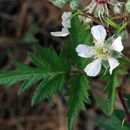More info for the terms:
adventitious,
apomixis,
duff,
fruit,
scarification,
seed,
stratificationEvergreen blackberry regenerates both sexually and through vegetative
means. Reproductive versatility is well represented in the Rubus genus,
with sexual reproduction, parthenogenesis (development of the egg
without fertilization), pseudogamy (a form of apomixis in which
pollination is required), and parthenocarpy (production of fruit without
fertilization) occurring widely. The following types of reproduction
have been documented in blackberries: (1) sexual reproduction, (2)
nonreduction at meiosis on the female, male, or both sides, (3) apomixis
with segregation, (4) apomixis without segregation, and (5) haploid
parthenogenesis [
7]. These modes of asexual reproduction help
contribute to the vigorous, aggressive spread of blackberries.
Vegetative regeneration: The mostly biennial stems of blackberries
typically develop from perennial rootstocks or creeping stems located
aboveground. Most species within the Rubus genus are capable of
vigorous sprouting from root or stem suckers and rooting stem tips [
14].
Evergreen blackberry produces numerous adventitious root suckers, even
in the absence of disturbance [
15]. These root suckers are presumably
capable of producing new primocanes as the connection to the parent
plant is eliminated. Evergreen blackberry also spreads rapidly as
aboveground vegetation roots at the nodes [
20]. Evergreen blackberry
typically sprouts vigorously following disturbance.
Seed: Most blackberries produce good seed crops nearly every year [
4].
During the first year of development, blackberries grow from perennial
rootstocks or creeping stems and produce sterile vegetative shoots known
as primocanes. Lateral branches (floricanes) develop in the axils
during the second year which produce both leaves and flowers [
14].
Immature fruit of the evergreen blackberry is a dull red [
4]. Ripe
berries are shiny black, and made up of relatively few large drupelets
[
4,
31,
32]. Cleaned evergreen blackberry seed averages approximately
137,000 per pound (301,762/kg) [
4]. Apomixis is particularly common in
the evergreen blackberry [
15].
Germination: Blackberry seeds have a hard impermeable coat and dormant
embryo [
2,
14]; consequently, germination is often slow. Most
blackberries require, as a minimum, warm stratification at 68 to 86
degrees F (20 to 30 degrees C) for 90 days, followed by cold
stratification at 36 to 41 degrees F (2 to 5 degrees C) for an
additional 90 days [
2]. These conditions are frequently encountered
naturally, as seeds mature in summer and remain in the soil throughout
the cold winter months. Scarification also appears to improve
germination. Laboratory tests indicate that exposure to sulfuric acid
solutions or sodium hyperchlorite prior to cold stratification can
enhance germination [
2]. Evidence suggests that avian digestive
processes can also help scarify the seed of blackberries [
14]. Results
of specific germination tests of blackberry seed are as follows [
14]:
seed pregerm. last germ. real amount potential
fed to: treatment of seed of germ. germ. (%)
(in days) (in # of (%) (% seeds still
days) alive at end
of test)
waxwing none -- 0 50
waxwing warm 90 + cold 90 -- 0 51
Am. robin none -- 0 66
Am. robin warm 90 + cold 90 41 17 60
n. catbird none -- 0 59
n. catbird warm 90 + cold 90 49 21 72
control none -- 0 81
control warm 90 + cold 90 27 3 81
Researchers observed that although some seed was mechanically damaged
while being ingested, intact seeds typically exhibited improved
germination [
14]. These test findings emphasized the importance of
prior cold stratification for best blackberry germination.
Seedbanking: Blackberry seed is typically long-lived when buried in the
soil or duff [
2,
15]. Researchers have located viable buried seed of the
evergreen blackberry at depths of 0 to 2 inches (0-5 cm) in coastal
Douglas-fir (Pseudotsuga menziesii) forests of British Columbia [
12].
Seed dispersal: Seed of evergreen blackberry is primarily animal
dispersed [
1]. After they mature, the highly sought-after fruits rarely
remain on the plants for long [
2].

